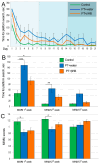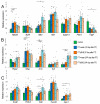Beta-Hydroxybutyrate Mitigates Sensorimotor and Cognitive Impairments in a Photothrombosis-Induced Ischemic Stroke in Mice
- PMID: 38891898
- PMCID: PMC11172083
- DOI: 10.3390/ijms25115710
Beta-Hydroxybutyrate Mitigates Sensorimotor and Cognitive Impairments in a Photothrombosis-Induced Ischemic Stroke in Mice
Abstract
The consequences of stroke include cognitive deficits and sensorimotor disturbances, which are largely related to mitochondrial impairments in the brain. In this work, we have shown that the mimetic of the ketogenic diet beta-hydroxybutyrate (βHB) can improve neurological brain function in stroke. At 3 weeks after photothrombotic stroke, mice receiving βHB with drinking water before and after surgery recovered faster in terms of sensorimotor functions assessed by the string test and static rods and cognitive functions assessed by the Morris water maze. At the same time, the βHB-treated mice had lower expression of some markers of astrocyte activation and inflammation (Gfap, Il-1b, Tnf). We hypothesize that long-term administration of βHB promotes the activation of the nuclear factor erythroid 2-related factor 2/antioxidant response element (Nrf2/ARE) pathway, which leads to increased expression of antioxidant genes targeting mitochondria and genes involved in signaling pathways necessary for the maintenance of synaptic plasticity. βHB partially maintained mitochondrial DNA (mtDNA) integrity during the first days after photothrombosis. However, in the following three weeks, the number of mtDNA damages increased in all experimental groups, which coincided with a decrease in Ogg1 expression, which plays an important role in mtDNA repair. Thus, we can assume that βHB is not only an important metabolite that provides additional energy to brain tissue during recovery from stroke under conditions of mitochondrial damage but also an important signaling molecule that supports neuronal plasticity and reduces neuroinflammation.
Keywords: ischemia; mitochondria; neuroprotection; oxidative stress; stroke.
Conflict of interest statement
The authors declare no conflict of interest.
Figures









Similar articles
-
Intranasal administration of mitochondria alleviated cognitive impairments and mitochondrial dysfunction in the photothrombotic model of mPFC stroke in mice.J Stroke Cerebrovasc Dis. 2022 Dec;31(12):106801. doi: 10.1016/j.jstrokecerebrovasdis.2022.106801. Epub 2022 Oct 17. J Stroke Cerebrovasc Dis. 2022. PMID: 36257142
-
Ischemic preconditioning provides long-lasting neuroprotection against ischemic stroke: The role of Nrf2.Exp Neurol. 2020 Mar;325:113142. doi: 10.1016/j.expneurol.2019.113142. Epub 2019 Dec 5. Exp Neurol. 2020. PMID: 31812555 Free PMC article.
-
Enriched environment improves post-stroke cognitive impairment and inhibits neuroinflammation and oxidative stress by activating Nrf2-ARE pathway.Int J Neurosci. 2021 Jul;131(7):641-649. doi: 10.1080/00207454.2020.1797722. Epub 2020 Jul 27. Int J Neurosci. 2021. PMID: 32677581
-
Transcriptional activation of antioxidant gene expression by Nrf2 protects against mitochondrial dysfunction and neuronal death associated with acute and chronic neurodegeneration.Exp Neurol. 2020 Jun;328:113247. doi: 10.1016/j.expneurol.2020.113247. Epub 2020 Feb 12. Exp Neurol. 2020. PMID: 32061629 Free PMC article. Review.
-
Targeting Transcription Factor Nrf2 (Nuclear Factor Erythroid 2-Related Factor 2) for the Intervention of Vascular Cognitive Impairment and Dementia.Arterioscler Thromb Vasc Biol. 2021 Jan;41(1):97-116. doi: 10.1161/ATVBAHA.120.314804. Epub 2020 Oct 15. Arterioscler Thromb Vasc Biol. 2021. PMID: 33054394 Free PMC article. Review.
Cited by
-
L-Carnitine and Mildronate Demonstrate Divergent Protective Effects on Mitochondrial DNA Quality Control and Inflammation Following Traumatic Brain Injury.Int J Mol Sci. 2025 Mar 22;26(7):2902. doi: 10.3390/ijms26072902. Int J Mol Sci. 2025. PMID: 40243464 Free PMC article.
-
β-hydroxybutyrate enhances brain metabolism in normoglycemia and hyperglycemia, providing cerebroprotection in a mouse stroke model.J Cereb Blood Flow Metab. 2025 Apr 12:271678X251334222. doi: 10.1177/0271678X251334222. Online ahead of print. J Cereb Blood Flow Metab. 2025. PMID: 40219805 Free PMC article.
-
Intermittent fasting, fatty acid metabolism reprogramming, and neuroimmuno microenvironment: mechanisms and application prospects.Front Nutr. 2024 Oct 24;11:1485632. doi: 10.3389/fnut.2024.1485632. eCollection 2024. Front Nutr. 2024. PMID: 39512520 Free PMC article. Review.
References
MeSH terms
Substances
Grants and funding
LinkOut - more resources
Full Text Sources
Medical
Research Materials
Miscellaneous

